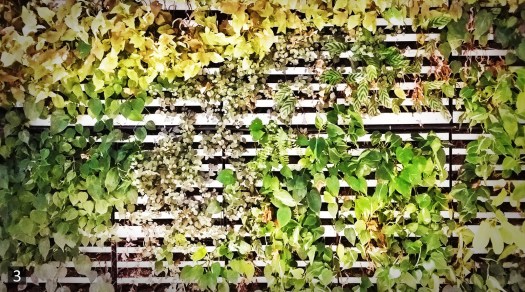In our previous article, we have talked about how to determine the effectiveness of vertical greenery systems (Link to article here). Some things to look out for include:
- Plant and substrate system
- Light provision
- Plant selection
- Irrigation
- Maintainability
The following is an example of green wall failure when one or more factors are not considered.
- It’s a small country
- Green wall and green roof installations are heavily promoted and subsidised
- Folks here like to have green walls both in the indoor and outdoor environment
We recently came across an example of green wall failure in a shopping mall located in Singapore. The reason for failure is quite clearly due to the lack of consideration for the following:
- Light provision
- Plant selection
Light provision
Figure 1 shows a green wall with 1 spotlight mounted on the ceiling. Since the spot light is located above the middle of the green wall and the discharge is rather focused, plants at the periphery will not be able to absorb any lighting.
Judging from the uneven distribution, it is our opinion that the spotlights are meant to be used as visual highlights and not growth lights. Nevertheless, plants in the middle of the green wall can be seen to be doing quite well from the added exposure. Perhaps a lighting strategy that caters to both aesthetics as well as plant health is in order.
Plant Selection
From Figure 1, we can see that whoever selected the plants has not considered the fact that plants may have different physical structures and growth rates.
Figure 2 shows 3 zones where the plants are not growing very well. We can observe that:
Zones 1 and 2 are patchy probably because they have very limited access to light.
Zone 3 may be patchy due to the type of plants used, and that any additional lighting from the spot light is blocked by plants above.
On a separate note, I find the excessive use of Aluminium strips….disturbing.
The plants look squashed (Figure 3). Spacing between planter boxes seems too tight and the ratio of metal strips to plants is disproportionate. There seems to be more metal than plants. This system may not be able to hold plants with long and thick stems.
Solution
The facilities manager of this shopping mall will probably have to do something about it sooner or later. Plants can be replaced, but if the same type plants are selected it will become a recurring issue. In order to prevent such failure, the following steps are recommended:
- Light provision study of wall using lux meter or PAR meter, so that you know what kind of lighting conditions you are dealing with
- Add more lights to ensure even distribution, but this will add to operations cost
- Choose the right plants for the right spot, by identifying areas with low light accessibility and allocating plants with low lighting requirements for such areas
How do we choose the right plants?
In this case, we can select plants based on physical structure and lighting requirement. Figure 3 shows how it can be done. In considering the side profile of a green wall, the realistic expectation is that some plants will tend to jut out of the wall more than others. Assuming growth lights to be shining down from the top, plants that jut out more should be placed at the lower portions of a green wall so that they will not block access to light for plants that jut out less.
Next, we can select plants that have extremely low requirements for lighting. UGL has been testing the minimum lighting levels required for plant growth (Link to articles here and here). We will share some of our findings from these experiments in the coming weeks.
Do let us know if you come across any examples of green wall failure. We will try to identify the reasons for failure and share our findings via this blog.
– T
References:






ivory caps skin whitening
ivory capsule
vien uong trang da ivory caps
ivory caps glutathione complex 1500 mg
thuoc ivory caps
thuoc trang da ivory caps
ivory caps whitening pills
thuốc uống làm trắng da ivory caps pills
thuốc uống trắng da
ivory cap pills
thuốc uống làm trắng da ivory caps
We are lucky to have a wide variety of evergreen trees. Whatever the reason, we hope you will like the range of trees of all sizes we have for you here. health benefits of super greens powder